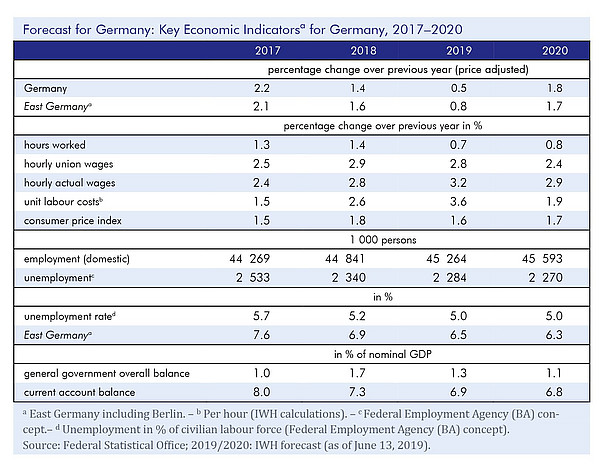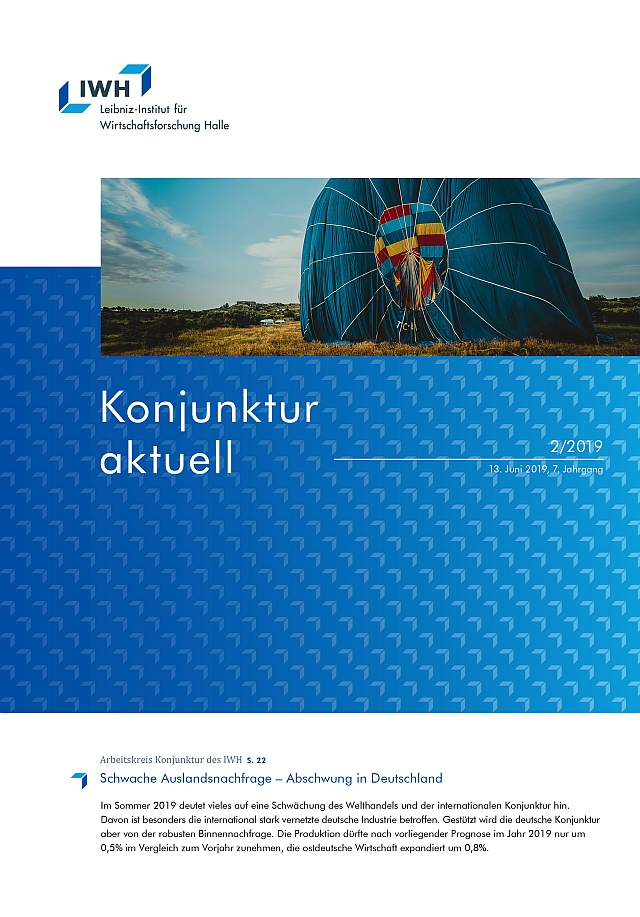Weak foreign demand – economic downturn in Germany

Recent developments are indicating that the trade frictions initiated by the United States are weakening world trade and the international economy. Yet more tariffs on Chinese goods seem likely and the IT sector, which is highly internationally connected, is weakened by licensing requirements for transactions with Chinese telecommunications providers. Worries about the state of the world economy have depressed prices for key industrial metals and oil. The strong economic expansion in the US will probably fade over summer, and financial markets expect the US Federal Reserve to lower its key interest rate in fall. In the Euro area gross domestic product is likely to expand below its potential growth rate of 1½% in 2019.
“The weakness of world trade is weighing particularly heavily on Germany’s internationally oriented manufacturing sector”, says Oliver Holtemöller, head of the Department Macroeconomics and vice president at the Halle Institute for Economic Research (IWH). The sharp decline in industrial production in April revealed that the unexpectedly strong first quarter in 2019 was largely driven by temporary factors, while the underlying trend remains anemic. However, throughout 2019 and supposedly 2020, the German economy will be supported by robust domestic demand. Private consumption continues to grow strongly, since incomes still rise. Significant wage increases coupled with ongoing job creation are pushing up unit labour costs. Sizeable price hikes, however, remain restricted to the construction industry. This year an expansionary fiscal policy impulse of 0.7% in relation to the gross domestic product also contributes to GDP growth. According to this forecast, real gross domestic product will be 0.5% higher in 2019 than in the previous year. In 2020, the growth rate will increase to 1.8% which is partially due to a higher number of working days. The East German economy expands by 0.8% this year and by 1.7% in 2020.
Publication
Brautzsch, Hans-Ulrich; Claudio, João Carlos; Drygalla, Andrej; Exß, Franziska; Heinisch, Katja; Holtemöller, Oliver; Kämpfe, Martina; Lindner, Axel; Müller, Isabella; Schultz, Birgit; Staffa, Ruben; Wieschemeyer, Matthias; Zeddies, Götz: Konjunktur aktuell: Schwache Auslandsnachfrage – Abschwung in Deutschland. Konjunktur aktuell, Jg. 7 (2), 2019. Halle (Saale) 2019.
Whom to contact
For Researchers

Vice President Department Head
If you have any further questions please contact me.
+49 345 7753-800 Request per E-MailFor Journalists

Internal and External Communications
If you have any further questions please contact me.
+49 345 7753-832 Request per E-MailIWH list of experts
The IWH list of experts provides an overview of IWH research topics and the researchers and scientists in these areas. The relevant experts for the topics listed there can be reached for questions as usual through the IWH Press Office.
Related Publications

Konjunktur aktuell: Schwache Auslandsnachfrage – Abschwung in Deutschland
in: Konjunktur aktuell, 2, 2019
Abstract
Im Sommer 2019 deutet vieles darauf hin, dass die neuerliche Verschärfung der amerikanischen Handelspolitik den Welthandel und die internationale Konjunktur schwächt. Auf chinesische Waren sollen neue Zölle erhoben werden, und der weltwirtschaftlich stark verflochtene IT-Sektor wird durch die Genehmigungspflicht von Geschäften mit wichtigen chinesischen Anbietern der Telekommunikationstechnik belastet. Konjunktursorgen haben die Preise für wichtige Industriemetalle sowie für Erdöl sinken lassen. Mittlerweile erwarten die Finanzmärkte, dass die US-Notenbank ihren Leitzins im Herbst senken wird. Trotzdem dürfte der US-Aufschwung im Sommerhalbjahr zu Ende gehen, und für die Produktion im Euroraum ist für diesen Zeitraum mit einer Expansion unterhalb der Potenzialrate von knapp 1½% zu rechnen. Von der Schwäche des Welthandels ist die international stark vernetzte deutsche Industrie besonders betroffen. Der deutliche Rückgang der Industrieproduktion im April lässt erkennen, dass die Belebung vom Jahresanfang vor allem auf temporäre Faktoren zurückging und die Grundtendenz der Konjunktur weiterhin schwach ist. Was die deutsche Konjunktur in diesem und wohl auch im nächsten Jahr stützen wird, ist die nach wie vor robuste Binnennachfrage. So bleibt der Zuwachs des privaten Konsums kräftig, denn die Einkommensentwicklung ist weiter positiv. Dazu trägt auch bei, dass von der Finanzpolitik in diesem Jahr ein expansiver Impuls im Umfang von 0,7% in Relation zum Bruttoinlandsprodukt ausgeht. Deutliche Lohnsteigerungen bei anhaltendem Beschäftigungsaufbau lassen die Lohnstückkosten stark steigen. Hohe Preissteigerungen bleiben aber auf die Bauwirtschaft beschränkt. Alles in allem liegt die Produktion nach vorliegender Prognose im Jahr 2019 um 0,5% höher als im Vorjahr, im Jahr 2020 steigt die Rate auch wegen der höheren Zahl an Arbeitstagen auf 1,8%. Die ostdeutsche Wirtschaft expandiert in diesem Jahr um 0,8% und im Jahr 2020 um 1,7%.



